Abstract
The growing importance of sustainable development, especially regarding environmental issues, contributes to shaping new trends at the level of enterprises. Sustainable development is perceived as a source of new entrepreneurial opportunities that serve to solve social and environmental problems. The main objective of this study is to identify factors supporting and hindering the development of enterprise innovativeness exemplified by the bioeconomy sector in Poland. A research analysis was based on the Entrepreneurial Discovery Process (EDP) model. The study employed the method of critical literature analysis, as well as qualitative methods, such as individual direct interviews with experts and smart labs with 252 enterprises from the economic sector. The results of the research analysis show that the innovative activity of enterprises in the bioeconomy sector depends on external, as well as internal, factors. This is particularly important, owing to the impact of enterprises on the environment and on society, as they contribute to the creation and implementation of new, more sustainable production and consumption models.
1. Introduction
Current developmental trends indicate the need to modernize the economy, taking into account notions of sustainable development. Sustainable development is a social model that cannot be attributed to any single scientific discipline. Issues regarding sustainable development are very complex and—in spite of many studies and publications in recent times—still not well recognized (Belz and Binder 2017). Due to global climate and environmental challenges, close cooperation between different disciplines is necessary. The growing importance of environmental issues and sustainable development contributes to the shaping of new trends at the enterprise level (Dean and Castillo 2013). Concepts which have been gaining importance since the 1990s is ecological (green or environmental) entrepreneurship, and recently, sustainable entrepreneurship. Sustainable entrepreneurship integrates the general concept of entrepreneurship with sustainable development, taking into account environmental, economic and social issues (Allen and Malin 2008; Horisch 2015). Based on a critical analysis of the literature on eco-friendly and/or sustainable entrepreneurship, there is a lack of conceptual development on the one hand (Thompson and Scott 2010), while, on the other, it is often linked to other related fields, such as innovation, technological development or strategic entrepreneurship (Covin and Miles 1999). In addition, the role of social and ecological problems as potential sources of entrepreneurial opportunities is largely unexplored. Sustainable entrepreneurship is still at a relatively early stage of development (Lenox and York 2011; Nagar et al. 2013). Especially in Polish literature, the concept of ecological or sustainable entrepreneurship is a completely new issue, which has hitherto rarely been the object of research by scientists (Solaja 2017; Urbaniec 2018). Nevertheless, in foreign literature, both concepts are currently the subject of scientific debate on the pages of prestigious mainstream business journals, such as Entrepreneurship: Theory and Practice, Journal of Business Venturing, Business Strategy and the Environment, and the Academy of Management Journal.
Eco-innovations play an important role in shaping sustainable development; they are not only a tool by which enterprises can build a competitive advantage, but are also a source of sustainable entrepreneurship development (Wagner 2009). As is apparent from the generally available literature, enterprises occupy a central place in the process of research on sustainable development, because they are direct users (consumers) of natural resources. The significant impact of increased environmentally-friendly activities on the part of enterprises is also visible in changed consumer attitudes toward the environment as well as in the environmental strategies of individual competitors. The development of ecological and/or sustainable entrepreneurship is crucial to the economy, because by undertaking various environmental-friendly activities at the enterprise level, it is possible to create appropriate conditions for the sustainable development of a given economy.
Bioeconomics is one area supporting sustainable development (EC 2012; OECD 2009; Vorgias 2018; Wield 2013). Bioeconomics is an interdisciplinary branch of the economy that can be defined as the sustainable use of renewable biological resources to create goods and services (Archer 2016; Bauer et al. 2018; Dinu 2019). The economy based on new biological technologies supports the creation of an innovative, resource-efficient and competitive economy that seeks to ensure food security with the use of renewable resources for industrial purposes; furthermore, its related branches are becoming among the largest employers (Hadynski 2015). Many factors influence the development of bioeconomics, including regulatory conditions, intellectual property, human resources, social acceptance, market structure and business models.
This allows us to formulate the research thesis that sustainable development at the core of the bioeconomy is seen as a source of new entrepreneurial opportunities that stimulate innovative enterprise development within the context of solving social and environmental problems.
The key objective of this study is to identify factors both supporting and hindering the development of enterprise innovativeness exemplified by the bioeconomy sector in Małopolska. The research analysis was based on the Entrepreneurial Discovery Process (EDP) model. On this basis, it is possible to determine which factors influence the innovative development of enterprises in accordance with the concept of sustainable entrepreneurship. Research on this issue involved the method of critical literature analysis as well as qualitative methods, such as individual direct interviews with experts and smart labs with 252 enterprises from the economic sector. This research contributes to the explanation of the role of innovation for sustainable entrepreneurship by focusing on internal and external factors that support and hinder the development of innovation in enterprises in the bioeconomy sector.
Therefore, first, the essence and significance of sustainable development with particular regard to the role of innovation as a source of sustainable entrepreneurship, using the example of the bioeconomy sector, will be depicted. Next, the key methodological assumptions of the conducted research will be indicated. In the remainder of this publication, the results of the research analysis of the motives and barriers to the development of enterprise innovativeness exemplified by the bioeconomy sector will be presented. Finally, conclusions will be presented and directions for future research proposed.
2. Literature Review
2.1. The Role of Sustainable Entrepreneurship in Sustainable Development
Sustainable development is perceived as a leading trend of socio-economic and environmental development at an international level, both in macro- and micro-economic terms. In the conceptual sense, sustainable development is understood as a process aimed at satisfying the developmental goals of the present generation in a way that enables the same needs to be met for future generations (WCED 1987). Starting with the classic definition included in the report prepared by the World Commission on Environment and Development, current literature on sustainable development provides many new interpretations, depending on the level of aggregation or thematic sphere. However, the lack of a precise and consistent meaning of this concept is still notable, as evidenced by the existence of almost 300 definitions of sustainable development (Johnston et al. 2007; Borys 2011; Redclift 2005). Nevertheless, the general consensus focuses on long-term sustainability and incorporates ecological, economic and social dimensions.
The implementation of sustainable development is associated with a fundamental change in management methods, taking into account systemic and integrated interdisciplinary approaches (Borys 2011; Urbaniec 2015). The need to change the current model of economic development to a more sustainable one was recognized as one of the priority areas not only by the United Nations (UN), but also by the Organisation for Economic Co-operation and Development (OECD) and the European Union (EU). Sustainable development is a concept that is gaining popularity as a new trend of socio-economic development around the world. Both in politics and industry, there is growing interest in supporting a sustainable economy in the context of the ever-changing conditions of social and economic development.
Intensified actions at the international level are now also reflected in the new Sustainable Development Goals (SDGs) set at UN level as part of the new document-based development agenda entitled “Transforming Our World: The 2030 Agenda for Global Action”, adopted at the UN Summit in New York on 25 September 2015 (UN 2015). In this agenda, 17 main goals and 169 related tasks were identified. Some of the goals (e.g., goal 8, 9 and 12) refer directly to sustainable development at the level of enterprises. These goals place emphasis on the promotion of developmental policy supporting production activity, entrepreneurship, creativity and innovation, encouraging the development of micro-, small- and medium-sized enterprises, as well as introducing the sustainable development of industry by increasing the efficiency of resource use and applying clean and environmentally-friendly technologies and production processes.
Therefore, there is a need for global change towards an environmental-friendly economy (green economy or circular economy). An eco-friendly economy cannot be imposed from the top down, but must be developed by entrepreneurs who react to policy incentives by implementing innovations in management and technology. Ecological products and technologies are finally marketed by so-called “Eco-entrepreneurs” who implement ideas by transforming prototypes into profitable, environmentally-friendly products.
In the era of intense development of a knowledge-based economy, enterprises increasingly consolidate their competitive position through innovative activities in the field of sustainable development or corporate social responsibility (Lin et al. 2015). One of the priorities for the development of enterprises from the 1990s is to conduct business taking into account the company’s impact on the environment and society, which has led to the development of what is know as green entrepreneurship or, more broadly, sustainable entrepreneurship (Hall et al. 2010).
Sustainable entrepreneurship as a new type of business opportunity represents a unique perspective that combines the creation of economic, social, and environmental values, with particular emphasis on the well-being of future generations (Hockerts and Wustenhagen 2010). In general, these issues are no longer seen as something that will have a negative impact on economic viability, but rather, as a part of the process of seeking answers, as well as balancing economic development, social justice and environmental quality (Cohen and Winn 2007). That is why new combinations and new ventures are needed (Korsgaard et al. 2016) which will contribute to the creation of new types of green or sustainable entrepreneurs that use natural resources in a more cost-effective way than before. Furthermore, Cohen and Winn (2007) define sustainable entrepreneurship as an opportunity to discover opportunities. This is connected with the way in which and by whom future goods and services are discovered, created and used, and their resulting economic, psychological, social and environmental consequences. They also emphasize that adding environmental effects is an expanded and significantly modified definition in the field of entrepreneurship (Cohen and Winn 2007).
Sustainable entrepreneurship means the idea of business development with a long-term perspective. From an economic perspective, some notions regarding ecological entrepreneurship theory were developed by Dean and McMullen (2007), taking into account, among others, the concept of market failure and environmental economics. According to their definition, problems related to the environment arise from the imperfections of the market, and as such, provide an opportunity for entrepreneurs, contributing to the improvement of the natural environment. Market failure in their model is understood as an opportunity that supports the development of entrepreneurship, assuming that the entrepreneur has knowledge concerning market failure. This means that market imperfections are the basic cause of pro-environmental entrepreneurial activity. Examples of market failure are public goods, externalities, monopoly power, government intervention, and incomplete market information (asymmetry of information).
The definitions of sustainable entrepreneurship existing in the literature show not only the diverse conceptual scope, but also the multi-faceted possibilities of interpreting sustainable entrepreneurship. These definitions indicate three attributes of sustainable entrepreneurship relating to: (1) the integration of environmental and social problems with economic benefits, (2) creating new values and innovations, (3) transforming companies, sectors or economies towards sustainable development (Urbaniec 2018). With these attributes in mind, sustainable entrepreneurship means a kind of business activity that creates new opportunities for the development of innovative activities of enterprises based on ecological and social issues.
Given the assumption that innovation is a key feature of sustainable entrepreneurship, it can be stated that innovative activity plays an important role in the process of transformation towards the sustainable development of enterprises, thus building a competitive advantage for them. As a result of innovative activities, enterprises achieve social, environmental and economic benefits, e.g., by creating new jobs, lifelong learning, developing skills, promoting new technologies, and the digital economy, as well as protecting the environment and engaging in efficient resource management (Hall et al. 2010; Wüstenhagen 2008). Innovations are interpreted in the literature generally not only as a tool for sustainable development to be applied at every stage of the life cycle of a product or service, but also in terms of the process and as a source of ecological and economic effects (Urbaniec 2015; Wüstenhagen 2008).
The essence of sustainable entrepreneurship is the discovery of new opportunities thanks to eco-innovation, while simultaneously committing to social and environmental responsibility. It should be added that the main goal of pro-environmental activities should not only be to improve the compliance of companies with environmental regulations, but also to increase their responsibility for environmental issues. As a result, they can contribute to the implementation of eco-innovations and achieving economic, ecological and social benefits that support their competitiveness, which is a manifestation of the transformation of enterprises towards sustainable entrepreneurship, understood as activities having a positive impact on the environment and providing a chance for innovative company development (Berger and Kuckertz 2016; Wagner 2009). Sustainable entrepreneurship as a new research area requires further research and interdisciplinary analyses supporting enterprises in implementing the concept of sustainable development.
It should therefore be emphasized that sustainability issues have also opened up new opportunities for entrepreneurship, and have introduced a new dimension to its research. This is because entrepreneurship has the potential to solve problems related to market imperfections in the market economy, in particular with respect to environmental issues (Cohen and Winn 2007; Melay and Kraus 2012). Although, in the last decade, European economies have noted progress in the field of integration of sustainable development, there is still much to be done in the shaping of entrepreneurship as a dynamic process leading to sustainable socio-economic development.
2.2. Eco-innovation for Sustainable Entrepreneurship in the Bioeconomy Sector
As a result of the growing importance of sustainable development, the direction of economic development is changing towards the intensification of production with the simultaneous sustainable use of natural resources, widespread use of technologies conducive to environmental protection, and renewable energy sources. These trends require support through the development of biotechnology, both in the field of industrial production, as well as in environmental protection. This is reflected in a new concept of development called the bioeconomy.
Bioeconomics refers to the activity of using biotechnology, bioprocess and bioproducts to create goods and services. There are several definitions of bioeconomy in literature (Lehtonen and Okkonen 2013; Vandermeulen et al. 2011). According to the OECD, bioeconomy refers to a set of economic activities related to the invention, development, production and use of biological products and processes (OECD 2009). Bioeconomics is based on the principle of sustainable development and includes three elements:
- the use of advanced knowledge about genes and cellular processes for the programming and development of new processes and new products;
- the use of renewable biomass and efficient bioprocesses to stimulate sustainable production;
- integrating of biotechnological knowledge for use in many sectors.
The bioeconomy is therefore an interdisciplinary branch of the economy which can be defined as the sustainable use of renewable biological resources to create goods and services. It involves the sustainable production and processing of broadly treated biomass for food, clothing, medicinal products, other industrial products and energy (Lehtonen and Okkonen 2013).
The dissemination of this concept took place in 2010–2013, which was supported by actions at the European Union level. According to the concept of the information gathering platform for the bioeconomy (BECOTEPS 2010), bioeconomics has included all sectors in which products are derived from biomass (agriculture, forestry and fisheries). Currently, bioeconomy means the sustainable production of renewable biological resources and their processing into food, feed and industrial products, as well as bioenergy. It is based on natural sciences, agronomy, ecology, food sciences, social sciences, biotechnology, nanotechnology, information and communication technologies (ICT), as well as engineering. It covers the following sectors: agriculture, forestry, fishing, food production, pulp and paper production, as well as chemical, biotechnology, energy and transport sectors (EC 2012).
This is the part of the economy that generates growth and creates jobs in the process of using and processing biological resources in an environmentally-friendly way through development (Maciejczak and Auzina 2016). At the European Union level, a significant role in the development of this concept was played by the strategy entitled “Innovating for Sustainable Growth: A Bioeconomy for Europe” (2012), which outlines the European Union’s action plan up to 2020 in the scope of changing the current European economy into an economy based on sustainable development and new biological technologies. The following issues are listed as priorities in this document (EC 2012):
- Ensuring food security,
- Sustainable management of natural resources,
- Reducing dependence on non-renewable resources,
- Mitigation of climate change and adaptation to it by developing production systems with lower greenhouse gas emissions,
- Creating jobs and maintaining the competitiveness of the European economy.
The EU’s current bioeconomy strategy aims to accelerate the implementation of a sustainable European bioeconomy so as to maximize its contribution to the 2030 and Sustainable Development Goals (SDGs) agenda, as well as to the Paris Agreement on a global response to the threat of climate change. This strategy is also a response to new European policy priorities, in particular, and a revised EU Industrial Policy Strategy, as well as a revolving approach to the field of clean energy. All these documents emphasize the importance of a sustainable circular bioeconomy (EC 2018).
Eco-innovations, which are seen not only as a catalyst for these changes, but also as a key element of EU policy for sustainable development in line with the Europe 2020 strategy, play a particularly important role in supporting sustainable development, also in the bioeconomy sector (EC 2010); (Schutte 2018; Urbaniec 2015). Eco-innovations are basically the same as innovations, but they stand out in two ways: (1) eco-innovation represents innovation leading to the reduction of environmental impact, regardless of whether or not this effect is expected; (2) the scope of eco-innovation can go beyond conventional organisational barriers and cover a wider social commitment generating changes within existing socio-cultural norms and institutional structures (Colombo et al. 2019; Leitao et al. 2019; Smol et al. 2017). This definition indicates socio-cultural and institutional contexts, among others, that often form the basis for creating standards for sustainable development. This means, therefore, that eco-innovations apply not only to products, processes, marketing methods and organisational methods, but also to social structures and institutional issues.
The overall goal of eco-innovation is to prevent or reduce negative impacts on the environment, to create new market opportunities, products, services or processes aimed at improving environmental performance (e.g., saving energy and other resources, as well as to reduce pollution and waste). Their implementation depends on, among other factors, the industry, legal regulations and standards, as well as the sensitivity and environmental awareness of consumers (Bossle et al. 2016; Leitao et al. 2019; Scarpellini et al. 2016).
In contrast to innovations, eco-innovations are determined not only by supply and demand determinants, but also by the market failure within the sphere of the environment. According to Porter’s hypothesis (Porter and Van der Linde 1995), demand for innovations may result from environmental regulations that may be beneficial for companies, drawing their attention to the possibilities of improving their business model, but also the qualification of the management staff, its knowledge of available efficiency-oriented solutions, and the ability to assess long-term benefits from their introduction. It should be added that eco-innovations are subject to the constant changes resulting from the current state of knowledge in the field of environmental protection and specific objectives at the enterprise level, as well as the national legal regulations, government programs and strategies, and international norms and standards supporting environmental protection and sustainable development. Eco-innovations depend on many interrelated factors, which differ depending on the level of development, market position or level of advancement of the enterprise’s technology.
3. Materials and Methods
3.1. Sample Selection and Research Tools
The key objective of this study is to identify factors both supporting and hindering the development of enterprise innovativeness exemplified by the bioeconomy sector in Małopolska (Lesser Poland), based on the Entrepreneurial Explore Process (EDP) Model. The EDP model was applied in 2018 within the “Avantgarde Initiative” Project in Małopolska owing to cooperation with the cluster of LifeScience Krakow, which brings together enterprises from the bioeconomy sector. Bioeconomics is an area included in the National Smart Specialisation in Poland, in particular within the LifeScience cluster (Ligenzowska 2015; Malopolska 2018). The list of 20 National Smart Specialisations developed by the Polish government is also reflected in regional strategies for smart specialisation (RIS3), which increases the chances of entrepreneurs operating under these specialisations in order to obtain additional points in the process of applying for financial support for public funds for RandD projects and innovations. The choice of regional specialisation in the field of bioeconomics for the research analysis is justified by the fact that enterprises in the bioeconomy sector are inherently oriented towards sustainable development as part of their operations according to the concept of sustainable entrepreneurship.
The research was carried out in 2018 in enterprises from the Małopolska province. Małopolska ranks third in Poland in terms of reported inventions and patents granted. In addition, the main centre of innovation in this region is the city of Kraków, which is a city with a very high level of innovation thanks to numerous scientific and research units, cluster initiatives, and companies investing in RandD (Ligenzowska 2015). The enterprises surveyed were classified into three categories: healthy food, biotechnological processes and specialty chemistry products, as well as environmental engineering. Among the companies declaring current activity in the healthy food sector, the majority deal with waste management, followed by food processing and food safety. Among companies declaring current activity in biotechnological processes, the majority deal with pollution reduction, followed by bioenergy, biofuels and environmental monitoring. The conducted research on the innovativeness of enterprises from the bioeconomy sector of the Małopolska region is an attempt to diagnose the degree of the sustainable development of enterprises, among others, in terms of motives and barriers to innovation and technology use.
The method used to carry out the study was qualitative research based on in-depth interview techniques (IDI) (Babbie 2013; Denzin and Lincoln 2005; Flick 2009). IDIs are among the most popular techniques in qualitative research. They are aimed at expanding knowledge on the studied phenomenon via an individual conversation between the moderator and the respondents, during which issues contained in the scenario previously agreed on with the client are discussed.
In order to carry out the research, in-depth interviews were conducted with 252 enterprises operating in the bioeconomy sector in Małopolska Voivodeship. The study was conducted among micro enterprises (35.3%), small and medium enterprises (41.4%) and large enterprises (23.4%). The largest group of respondents were companies operating on the market over 25 years (23.2%), as well as companies existing on the market less than 5 years (20.2%). These companies belong to eleven sections according to the Polish Classification of Activities (so called PKD code classification). Most companies represent the manufacturing section (40%) and professional, scientific and technical activities (24%) (Table 1).

Table 1.
Profile of companies participating in the study according to the PKD code classification.
The study used an interview questionnaire employing a targeted selection method (selection of experts). Interviews were conducted by experienced researches who filled out the questionnaire during the interview and prepared a summary of it following its completion. In-depth interviews were conducted in the form of direct meetings and telephone conversations with the chairmen of company management boards, branch directors, managers, as well as business owners or founders. Interviews were conducted—in accordance with the EDP methodology—with management staff. Respondents were asked many questions concerning various areas, ranging from the role of smart specialisations and human capital, through economic conditions to questions related to broadly understood innovativeness (e.g., innovative processes, innovation management, drivers of innovation, sources of information about innovations, barriers to innovation, use of technology, financial needs, relationship management). Bearing in mind the research objective of this article, the results concerning factors supporting and hindering the innovation development of enterprises from the bioeconomy sector in Małopolska region will first be presented.
3.2. Data Analysis Methods
As part of the research analysis concerning the innovativeness of enterprises dealing with the bioeconomy in the Małopolska region, the Entrepreneurial Discovery Process (EDP) model was used. The goal of the EDP is to identify areas characterized by the high growth of development potential (Mariussen et al. 2019; Mieszkowski et al. 2017). Thanks to the promotion of smart specialisations and the discovery of new business areas, this model prevents the creation of traditional industrial policy. The main goals of EDP include (Charles and Ciampi Stancova 2017):
- maximising public-private entrepreneurial discoveries;
- providing operational facilities that allow for continuous observation, exploration and evaluation;
- encouraging companies to share their knowledge of markets and technologies with public administration;
- supporting the early development of priority actions;
- spreading knowledge so as to generate more experiments and discoveries, and build critical mass.
EDP consists of several key elements. They originate primarily from innovative policies and good European practices. These are (WorldBank 2015):
- interviews—direct in-depth interviews with entrepreneurs (managers, directors, presidents, business owners) carried out by experts on the basis of an interview questionnaire consisting of qualitative and quantitative questions;
- smart labs—a series of meetings designed to quickly test the potential of the area of business in which participants (about 15–20 people representing enterprises, scientists, business environment institutions, and administration) declare their will to meet again;
- crowdsourcing—campaign aimed at involving enterprises to co-create innovation policy and enable dialogue between the private and public sectors;
- innovation maps—data collection and analysis based on applications for co-financing innovative activities, which are a source of information on business and technological trends.
The EDP model was applied in 2018 as part of the “Avantgarde Initiative” Project in Małopolska, as the only region in Poland and the first in Central and Eastern Europe. Implementation of the model was possible owing to cooperation with the cluster of LifeScience Krakow, which brings together enterprises from the bioeconomy sector. The research results presented in this article are based primarily on interviews and smart labs. In contrast to surveys carried out by the Central Statistical Office of Poland and questionnaires prepared by different international and private institutions, the main advantage of interviews within the EDP rely on taking place during individual meetings, where the participants are representatives of the top management or owners of the company. Each interview is based on a questionnaire containing 100 questions. After each interview, the expert prepares a one-page summary (WorldBank 2015).
Based on interviews conducted with entrepreneurs, real motives and barriers to the development of innovativeness of enterprises operating in the Małopolska Voivodeship in the field of National Intelligent Specialisations in the area of bioeconomics will be identified. This will make it possible to determine which factors influence innovation development in enterprises from the bioeconomy sector, in line with the concept of sustainable entrepreneurship.
4. Research Results
4.1. Drivers of Innovation
In order to be able to assess the factors supporting and hindering the development of innovation in enterprises from the bioeconomy sector, their level of innovativeness will first be analyzed. Over 50% of the enterprises surveyed indicated that they either had an innovation strategy or that innovations were part of their general strategy. However, only 40% indicated that they had a research and development department or human resources involved in research and development. One should positively assess the fact that 55% of the surveyed companies have a mechanism for knowledge management, 49% have their own patents and licenses, and 42% have procedures in place for verifying innovative ideas. Respondents also point to similar incentives for innovations, i.e., for the Internet, customers and internal resources of the company. However, as many as 64% declare that their motivational system stimulates risk-taking and innovation. As part of their innovative activity, the companies surveyed implemented mainly process and product innovations over the last three years. Most of them were implemented on the national level (Figure 1 and Figure 2).
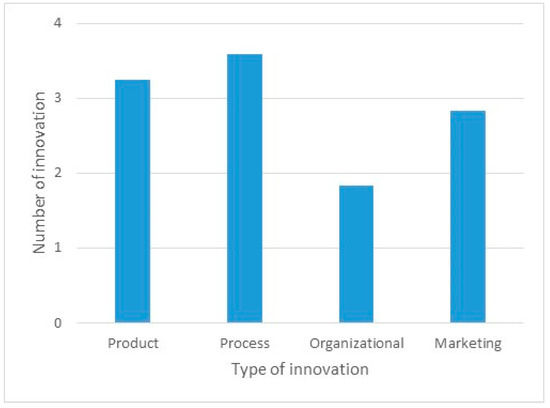
Figure 1.
Average number of innovations rolled out over the past 3 years by type.
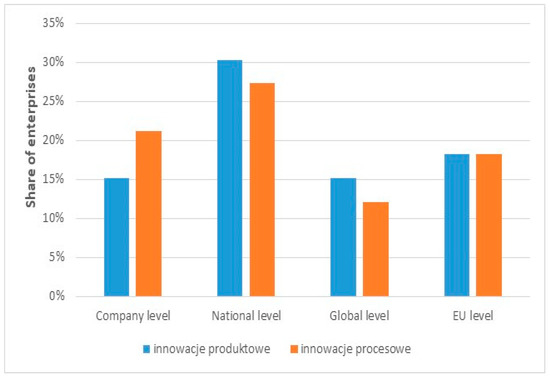
Figure 2.
Scope of innovations.
Bearing in mind the research goal, it was important to identify the drivers of innovation and their incidence in companies. These were defined in three stages. In the first stage, factors such as: intellectual property rights, legislation, new market opportunities/trends, new product development, certification/other standards, sources of financing and product quality were taken into account. Over 20% of respondents recognized that legislation was either never or very seldom a factor driving the innovation of their company (Figure 3). On the other hand, sources of financing, product quality and new market opportunities have been identified as key factors of company innovation.
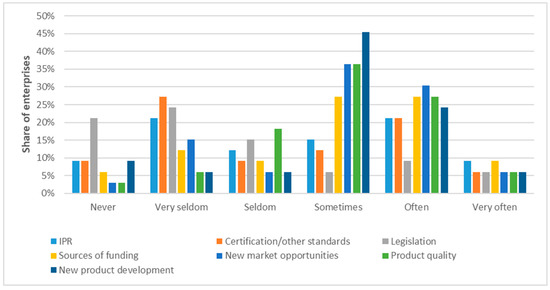
Figure 3.
Drivers of innovation (part 1).
The second stage includes factors related to external stakeholders: competition, customers and suppliers (Figure 4). An important factor driving innovations according to respondents are customers and competition. It can be concluded that companies analyze the actions of competitors in the context of identifying customer needs.
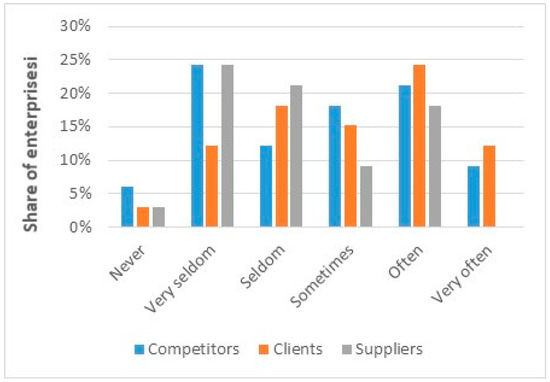
Figure 4.
Drivers of innovation (part 2).
The third stage took into account the perspective of internal stakeholders and their attitude towards innovation (Figure 5). To this end, the attitude of the management board, the RandD department, and employee initiatives in the field of innovation support were examined. The analysis shows that over 50% of companies indicated the attitude of their management as the key driver of innovation. The involvement of employees (over 30%) also plays a significant role. Only 15% of companies indicated the RandD department as a key stimulant of innovation. It should be added that most enterprises are skeptical about the idea of cooperating with the public sector. As a rule, companies do not cooperate with business support institutions or RandD centres, expressing concerns about the quality of the services offered by these institutions.
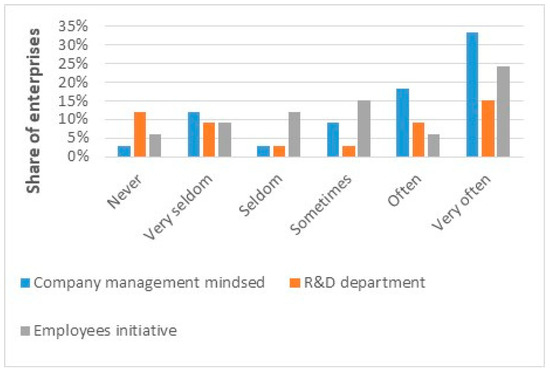
Figure 5.
Drivers of innovation (part 3).
Due to the fact that the bioeconomy sector relies heavily on new technological solutions, the study also takes into account the impact of the technological advancement of enterprises in their innovation. To this end, issues related to the acquisition of new technologies, the development of own technologies, the use of key enabling technologies, as well as the use of IT systems, were analyzed.
Although the key factor affecting the innovation level of enterprises might seem to be the procurement of new technologies, the surveyed companies use this process only to a small extent (Figure 6). Taking into account the development of own technologies, the involvement of companies is greater, with 48% of companies participating in the survey gave a positive answer (Figure 7). Nevertheless, over 50% of companies participating in the survey declared that they do not develop their own technologies. This may indicate both a lack of own funds or a lack of market demand for the forms of eco-innovation offered by these companies.
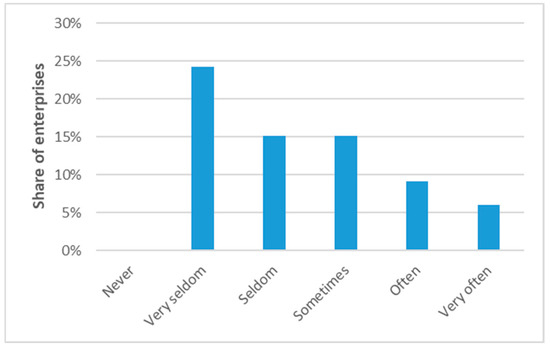
Figure 6.
Procurement of new technologies.
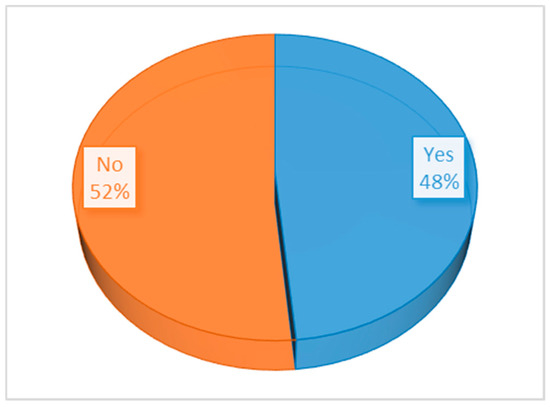
Figure 7.
Developing company’s own technologies.
Taking into account Key Enabling Technologies (KET), the surveyed companies primarily indicated the use of advanced materials (polymers, biomaterials, optical materials, etc.) as well as micro- and nano-electronics. Only 12% of companies exploit nanotechnology (Figure 8). In analyzing the IT systems used by companies (i.e., CRM, CAM, CAD and others), it can be seen that most of the companies surveyed (over 60%) do not take advantage of such solutions (Figure 9).
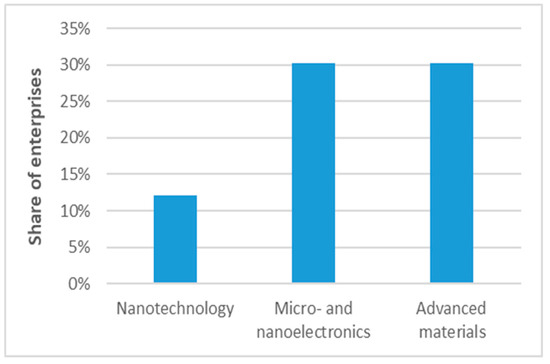
Figure 8.
The use of Key Enabling Technologies.
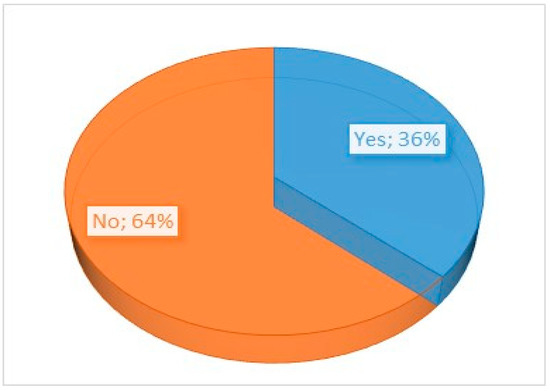
Figure 9.
The use of IT systems (CRM, CAM, CAD, etc.).
To summarize, the surveyed companies are aware of the need to manage innovations. The question of whether the researched companies are able to develop innovations systematically was positively answered by over 66% of the surveyed companies, which is a promising indicator for the future. Factors supporting the development of innovations in enterprises from the bioeconomy sector include internal factors (such as: product quality, the attitude of the management, employees initiatives), as well as external factors (such as sources of financing, new market opportunities, clients and competition). Nevertheless, the presented analysis shows that enterprises from the bioeconomy sector in Małopolska Voivodeship should intensify their investment activities using modern technologies within the scope of creating their own technological solutions as, owing to this, they will be able to consolidate their positions on the market and increase their competitiveness.
4.2. Barriers to Company Innovativeness
On the basis of the research conducted, factors hindering the development of innovations were identified among enterprises from the bioeconomy sector. Among the most important barriers to the development based on innovation, companies indicated access to finance. When analysing the financial needs of the surveyed companies, it becomes apparent that for nearly 60% of them, funding, either directly or indirectly, represents a significant barrier to innovation (Figure 10). The relation between decreasing profit margins and innovative activities varies from company to company, with approximately 15% of respondents reporting a strong link, and 18% claiming the opposite (Figure 11).
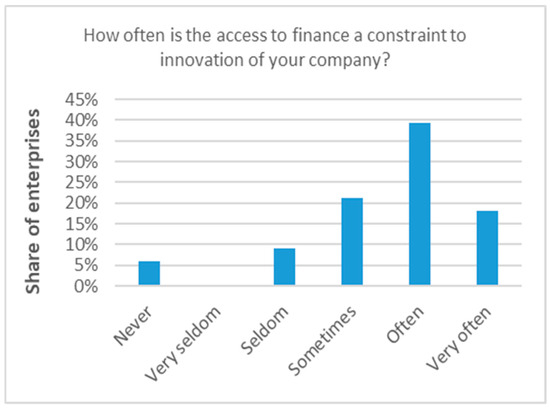
Figure 10.
Financial barriers to innovation.
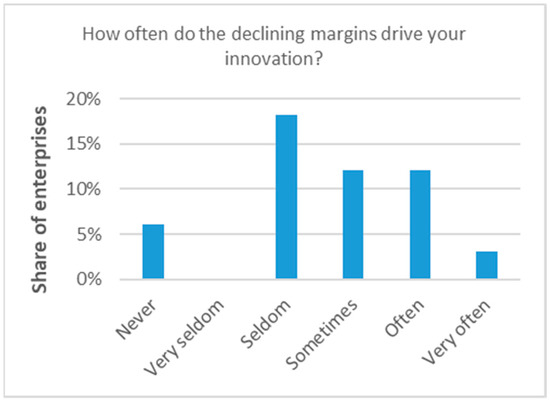
Figure 11.
Role of decreasing profit margins in promoting innovation.
When asked about the most attractive sources of financing the innovative activity of enterprises, respondents indicated European Union subsidies (45%) and own capital (33%). Furthermore, over 70% of companies declare a very strong awareness of regional and national resources. Nevertheless, companies know that there are public innovation support programs, but they do not know the details (i.e., which instruments are specifically offered and how to access them).
Analyzing the remaining innovation barriers, enterprises from the bioeconomy sector were most often restricted by legislation and technical constraints. It should be added that eco-innovations constitute a specific type of innovation, which is also why, in the area of bioeconomics, key innovation barriers result from legal regulations. Access to both soft (e.g., managerial) and hard (mainly technical) skills was defined as a non-significant barrier (Figure 12). In addition to the abovementioned barriers, most enterprises indicated that competitors or suppliers are rarely a barrier (Figure 13). Stakeholders were assessed by the surveyed companies as a factor supporting the development of innovation.
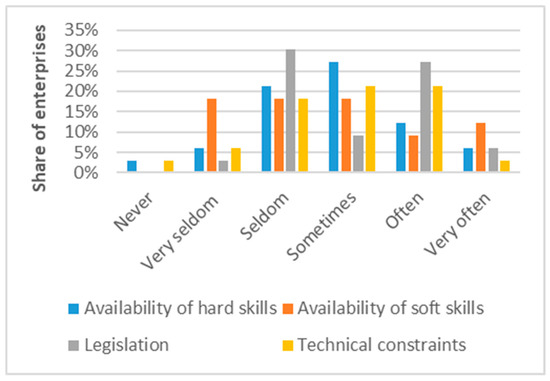
Figure 12.
Barriers to company innovation.
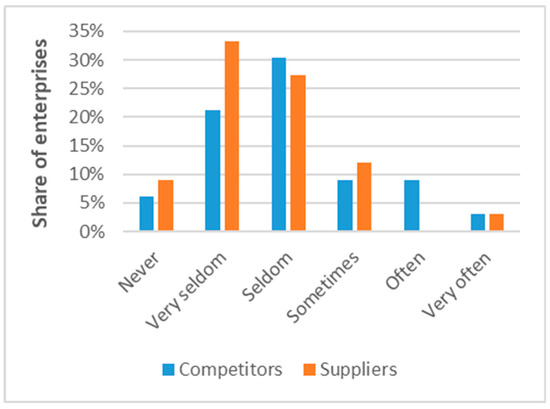
Figure 13.
Barriers to company innovation.
In conclusion, it can be stated that entrepreneurs in the Małopolska region see an increasing need to innovate. Nevertheless, among the factors hindering the development of innovation, the surveyed companies primarily point to external factors, such as access to financing and legal issues. In contrast, technical constraints are among the internal factors that hamper the development of innovation.
5. Discussion
The paper sets out to answer the following question: Which factors influence the innovation development in enterprises from the bioeconomy sector in line with the concept of sustainable entrepreneurship?
Bioeconomics is a sector which, in the case of Małopolska, has very large potential for impact on economic and social development (Kokoszka and Pink 2017). Its development based on innovative technologies, processes and products can contribute to increasing the effectiveness and efficiency of production of safe and high-quality food. It can also generate an increase in sales and profitability, not only in the food and agricultural industry, but also in other industries. Bioeconomics gives Małopolska region a chance to build its own brand (Kokoszka and Pink 2017). It should be emphasized that the local economy development plan in the Małopolska Voivodeship should be based on the meaning of the bioeconomy in which we deal with the sustainable use of renewable biological resources, based on biotechnological innovations in production processes, in order to meet private and public needs. As indicated in literature (Żmija and Czekaj 2014), the Małopolska Voivodeship has development opportunities in many areas related to the bioeconomy sector. Agricultural producers from the region are able to ensure food security. In addition, natural resources are a source of raw materials for the energy industry, chemical industry and biotechnology.
The Entrepreneurial Discovery Process (EDP) model applied to the innovation in enterprises from the bioeconomy sector enables a new approach to the identification, verification and modification of research and innovation strategies for smart specialisation (RIS3). This should also lead to the modification of policy directions, from programs built on the basis of the top-down, supply-side approach, to programs based on the bottom-up demand of enterprises and the economy. The EDP model should also help address market failures and coordination gaps, as well as help the private sector gain a critical mass of innovation-based development that will consolidate entrepreneurial discovery. As a result, the implementation of EDP should provide a higher return on public investment in innovation and fuel more rapid growth of the labor productivity that is necessary for the further convergence of Poland with the countries of Western Europe (WorldBank 2015).
The empirical analysis shows that companies from the bioeconomy sector are characterized by high innovativeness; in the last three years, more than half implemented at least one innovation. The results of the research analysis show that the development of the innovativeness of enterprises, enabling the creation and implementation of new, more sustainable production and consumption models, depends on both internal and external factors (Table 2). The most important factors supporting the development of innovation include sources of financing, product quality, as well as the impact of internal (management, employees) and external (clients, competitors) stakeholders. The most important barriers to innovation development include difficulties in access to financing and legislation, as well as technical constraints.

Table 2.
Motives and barriers to innovation in enterprises form the bioeconomy sector.
The identified motives supporting the development of innovation also overlap, to a large extent, with motives for the development of sustainable entrepreneurship. For example, the ability to transform ecological issues into effective organic products through effective strategic planning and marketing can be indicated (Shepherd and Patzelt 2013). Innovation is important in terms of entrepreneurial benefits and the implementation of new opportunities (Wagner 2009). Environmental benefits may be the primary goal of innovation or they may result from other assumptions. Other studies also confirm that the effectiveness of implementing measures in the field of sustainable development depends, among others, on the personal involvement and support of managers (Rainey 2010).
Analysing barriers to the development of innovation, the wide range of hindering factors reflected in sustainable entrepreneurship can be determined. According to Newton (2005), the key barriers to green or sustainable entrepreneurship include a lack of implementing rules and insufficient protection of intellectual property rights.
Although legal regulations have been indicated by the surveyed enterprises as a factor hampering the development of innovations, many other studies can be found in literature, which are cautious about the fact that legislation, particularly in the field of environmental protection, can be a supporting factor. Particularly noteworthy in this context is the so-called Porter’s hypothesis (Bitat 2012). According to this hypothesis, restrictive environmental regulations can increase productivity and encourage innovation, which contribute to improving the competitiveness of enterprises. Porter and Van der Linde (1995) emphasize that properly designed legal regulations in this area may have an impact on the direction of innovation, including by motivating to implement innovation and achieve progress. This is dependent on, among other factors, the institutional context and the size of the enterprise.
On the basis of our research analysis, it can be stated that the problem of enterprises from the bioeconomy sector in Małopolska region is currently a lack of knowledge regarding the methods of obtaining subsidies for innovative activities and lack of cooperation with scientific and research units, which is reflected in the technical constraints indicated by respondents. In analysing technical limitations as a barrier to the development of innovation, it should be added that not all innovations or technological solutions lead to sustainable entrepreneurship. Firstly, sustainable technology means more than just producing goods without pollution or environmental damage. Sustainable technology means meeting people’s needs in a such way that the regeneration capacity of the planet is not exceeded, as well as developing the ability to recover local ecosystems (Mulder 2007). The goal is to use natural global resources within the limits set by the ability to recover land. What are the prerequisites for these innovations in the field of sustainable development?
In addition, when comparing studies carried out under other smart specialisations, enterprises typically report similar innovation-friendly factors and similar obstacles to innovation, suggesting that there is a large field for horizontal support programs (WorldBank 2015). It should be added that Poland is currently at an early stage of implementing eco-innovation, and the green economy in general. National policy should promote and facilitate cluster initiatives, such as the LifeSciece cluster, which includes the bioeconomy sector in Małopolska Voivodeship, by establishing closer and more effective links between industry and education, as well as between public and private sectors. It is expected that the intensification of cluster development in the Polish economy in the time horizon of 2020 will contribute to a significant increase in its competitiveness and innovation.
Our study also has both theoretical and practical contributions. The theoretical implications focus on the explanation of the role of innovation for sustainable entrepreneurship by focusing on internal and external factors that support and hinder the development of innovation in enterprises from the bioeconomy sector. From a practical perspective, our research can provide more detailed guidance for managers on how to identify and implement improvements in environmental and economic performance that impact of innovativeness of enterprises and contribute to the creation and implementation of new, more sustainable production and consumption models.
6. Conclusions
The increasing pace of environmental and technological changes has a significant impact on all organisations, including enterprises. In today’s dynamic and uncertain economic environment, companies and organisations are trying to find new ways of achieving their strategic goals and ensuring long-term success. The current state of development shows that there are many opportunities for synergy between sustainable development and entrepreneurship. Entrepreneurship plays an important role in the implementation of sustainable development, because it gives rise to the search and implementation of new solutions to meet social and ecological problems from the perspective of enterprises. Sustainable entrepreneurship is closely related to ecological innovations that may be reflected in various changes in technology, products, organisational structure and organisation management, limiting negative impact on the natural environment. This means that taking actions for sustainable development is not only an opportunity for innovative enterprise development, but also that doing so supports overcoming existing problems. The key feature of sustainable entrepreneurship is not only solving environmental and social problems and achieving economic benefits, but also creating new values and innovations and transforming companies, sectors or economies towards sustainable development. All these features are an important issue in the context of current opportunities and challenges related to the implementation of sustainable entrepreneurship in enterprises from the bioeconomy sector.
The results of the analysis indicate that companies from the bioeconomy sector operating in the Małopolska region show great commitment to innovative solutions. The main goal of innovative actions undertaken by enterprises from the bioeconomy sector is the implementation of eco-innovations and achieving economic and ecological benefits, which is a manifestation of the transformation of enterprises towards sustainable entrepreneurship, understood as an activity having a positive impact on the environment, and a chance for innovative company development.
In order to examine the determinants of the development of innovation in these enterprises, the EDP model was used, which makes it possible to identify key factors both supporting as well as hindering the development of innovation in enterprises from the bioeconomy sector. On the basis of the conducted analysis, it can be stated that the innovativeness of the surveyed enterprises is dependent on both internal and external factors. The most important factors supporting the development of innovation include sources of financing, product quality, as well as the impact of internal (management, employees) and external (clients, competitors) stakeholders. The most important barriers to innovation development of companies include difficulties in access to financing and legislation as well as technical constraints. This means that the identified motives and barriers to eco-innovatiron in the bioeconomy sector are similar to those that stimulate or limit the development of sustainable entrepreneurship. This is related to the fact that eco-innovations generate changes not only in enterprises, but also in their environment, i.e., within existing socio-cultural norms and institutional structures (Urbaniec 2015).
To sum up, eco-innovation within the context of sustainable entrepreneurship is seen as a new research area requiring further research into environmental protection mechanisms and ecosystems while ensuring economic and non-economic benefits for investors, entrepreneurs and society (Shepherd and Patzelt 2011). Therefore, it is important to conduct exploration and interdisciplinary analyses that will contribute to a better understanding and development of appropriate business models supporting enterprises from the bioeconomy sector in implementing innovation. Sustainable entrepreneurship is a complex concept that cannot be attributed to any single discipline. Interdisciplinarity in research on the sustainable development of enterprises and their innovation means that the methodology of economics should employ various disciplines and methods to describe and explain scientific facts.
This study was conducted within the specific context of enterprises from the bioeconomy sector, and the transfer of results to other sectors should not be taken for granted, although the theoretical reasoning and conclusions from this research are not specific to this context. Nonetheless, this requires further investigation. For example, the drivers and barriers of innovation could be examined through the use of other tools of the EDP model, e.g., innovation maps. Another possible limitation is that the study has only considered selected factors and barriers in the bioeconomy sector, due to the EDP methodology. In conclusion, although significant progress has been achieved in the field of innovation drivers and barriers, there are still opportunities for future innovation development in enterprises of the bioeconomy sector.
Author Contributions
These authors contributed equally to this work: conceptualization, M.S., M.U. and M.W.; methodology, M.S. and M.W.; research analysis, MS., M.U. and M.W.; investigation, M.S. and M.W.; visualization, M.W.; writing—original draft preparation, M.S, M.U. and M.W.; writing—review and editing, M.U.
Funding
This research was funded by the Ministry of Science and Higher Education of the Republic of Poland within “Regional Initiative of Excellence” Programme for 2019-2022 (Project no.: 021/RID/2018/19).
Conflicts of Interest
The authors declare no conflict of interest. The funder had no role in the design of the study; in the collection, analyses, or interpretation of data; in the writing of the manuscript, or in the decision to publish the results.
References
- Allen, John C., and Stephanie Malin. 2008. Green Entrepreneurship: A Method for Managing Natural Resources? Society and Natural Resources 21: 828–44. [Google Scholar] [CrossRef]
- Archer, Ian. 2016. Driving the development of the bioeconomy through innovation. New Biotechnology 33: S67. [Google Scholar] [CrossRef]
- Babbie, Earl R. 2013. The Practice of Social Research, 13th ed. Belmont: Wadsworth Publishing. [Google Scholar]
- Bauer, Fredric, Teis Hansen, and Hans Hellsmark. 2018. Innovation in the bioeconomy—Dynamics of biorefinery innovation networks. Technology Analysis and Strategic Management 30: 935–47. [Google Scholar] [CrossRef]
- BECOTEPS. 2010. Bio-Economy Technology Platforms. Available online: https://cordis.europa.eu/project/rcn/90971/factsheet/en (accessed on 24 May 2019).
- Belz, Frank Martin, and Julia Katharina Binder. 2017. Sustainable Entrepreneurship: A Convergent Process Model. Business Strategy and the Environment 26: 1–17. [Google Scholar] [CrossRef]
- Berger, Elisabeth S. C., and Andreas Kuckertz. 2016. Complexity in Entrepreneurship, Innovation and Technology Research: Applications of Emergent and Neglected Methodsfgf Studies in Small Business and Entrepreneurship. Cham: Springer International Publishing. [Google Scholar]
- Bitat, Abdelfettah. 2012. Impact of Eco-Innovation on Firms Competitiveness. An Empirical Study Based on Mannheim Innovation Panel. Available online: http://www.memoireonline.com/05/12/5870/Impact-of-eco-innovation-on-firms-competitiveness-An-empirical-study-based-on-Mannheim-Innovation.html (accessed on 24 May 2019).
- Borys, Tadeusz. 2011. Sustainable Development—How to Recognize Integrated Order. Problemy Ekorozwoju 6: 75–81. [Google Scholar]
- Bossle, Marilia Bonzanini, Marcia Dutra De Barcellos, and Luciana Marques Vieira. 2016. Why food companies go green? The determinant factors to adopt eco-innovations. British Food Journal 118: 1317–33. [Google Scholar] [CrossRef]
- Charles, David, and Katerina Ciampi Stancova. 2017. Entrepreneurial discovery process and research and technology organisations. In Governing Smart Specialisation. Edited by Dimitrios Kyriakou, Manuel Palazuelos Martínez, Inmaculada Periáñez-Forte and Alessandro Rainoldi. New York: Routledge, vol. 106, pp. 80–94. [Google Scholar]
- Cohen, Boyd, and Monika I. Winn. 2007. Market imperfections, opportunity and sustainable entrepreneurship. Journal of Business Venturing 22: 29–49. [Google Scholar] [CrossRef]
- Colombo, Laura Antonella, Mario Pansera, and Richard Owen. 2019. The discourse of eco-innovation in the European Union: An analysis of the Eco-Innovation Action Plan and Horizon 2020. Journal of Cleaner Production 214: 653–65. [Google Scholar] [CrossRef]
- Covin, Jeffrey G., and Morgan P. Miles. 1999. Corporate Entrepreneurship and the Pursuit of Competitive Advantage. Entrepreneurship Theory and Practice 23: 47–63. [Google Scholar] [CrossRef]
- Dean, Thomas, and Jacob T Castillo. 2013. Sustainable Venturing: Entrepreneurial Opportunity in the Transition to A Sustainable Economy, International ed. Upper Saddle River: Pearson Education Ltd. [Google Scholar]
- Dean, Thomas, and Jeffery S. McMullen. 2007. Toward a theory of sustainable entrepreneurship: Reducing environmental degradation through entrepreneurial action. Journal of Business Venturing 22: 50–76. [Google Scholar] [CrossRef]
- Denzin, Norman K., and Yvonna S. Lincoln. 2005. Introduction: The Discipline and Practice of Qualitative Research. In Handbook of Qualitative Research, 3rd ed. Edited by Norman K. Denzin and Yvonna S. Lincoln. Thousand Oaks: Sage, pp. 1–32. [Google Scholar]
- Dinu, Vasile. 2019. The Transition to Bioeconomy. Amfiteatru Economic 21: 5–7. [Google Scholar] [CrossRef]
- EC. 2010. Europe 2020. A Strategy for Smart, Sustainable and Inclusive Growth, COM(2010) 2020. Available online: https://eur-lex.europa.eu/LexUriServ/LexUriServ.do?uri=COM:2010:2020:FIN:EN:PDF (accessed on 27 May 2019).
- EC. 2012. Innovating for Sustainable Growth: A Bioeconomy for Europe. Communication from the Commission to the European Parliament, the Council, the European Economic and Social Committee and the Committee of the Regions, com(2012) 60 Final. Brussels: European Commission. [Google Scholar]
- EC. 2018. A Sustainable Bioeconomy for Europe: Strengthening the Connection between Economy, Society and the Environment. Luxembourg: Publications Office of the European Union. [Google Scholar]
- Flick, Uwe. 2009. An Introduction to Qualitative Research, 4th ed. Thousand Oaks: Sage Publications Ltd. [Google Scholar]
- Hadynski, Jakub. 2015. The bio-based economy in the European Union’s development strategies. Economic and Regional Studies 8: 46–54. [Google Scholar]
- Hall, Jeremy K., Gregory A. Daneke, and Michael J. Lenox. 2010. Sustainable development and entrepreneurship: Past contributions and future directions. Journal of Business Venturing 25: 439–48. [Google Scholar] [CrossRef]
- Hockerts, Kai, and Rolf Wüstenhagen. 2010. Greening Goliaths versus emerging Davids—Theorizing about the role of incumbents and new entrants in sustainable entrepreneurship. Journal of Business Venturing 25: 481–92. [Google Scholar] [CrossRef]
- Horisch, Jacob. 2015. The Role of Sustainable Entrepreneurship in Sustainability Transitions: A Conceptual Synthesis against the Background of the Multi-Level Perspective. Administrative Sciences 5: 286–300. [Google Scholar] [CrossRef]
- Johnston, Paul, Mark Everard, David Santillo, and Karl-Henrik Robèrt. 2007. Reclaiming the definition of sustainability. Environmental Science and Pollution Research International 14: 60–66. [Google Scholar] [PubMed]
- Kokoszka, Katarzyna, and Małgorzata Pink. 2017. Bioeconomy—Opportunities and Threats in Malopolska Voivodship (Poland). Paper Presented at the 8th International Scientific Conference Rural Development 2017, Aleksandras Stulginskis University, Lithuania, November 23–24. [Google Scholar]
- Korsgaard, Steffen, Alistair Anderson, and Johan Gaddefors. 2016. Entrepreneurship as re-sourcing Towards a new image of entrepreneurship in a time of financial, economic and socio-spatial crisis. Journal of Enterprising Communities-People and Places in the Global Economy 10: 178–202. [Google Scholar] [CrossRef]
- Lehtonen, Olli, and Lasse Okkonen. 2013. Regional socio-economic impacts of decentralised bioeconomy. A case of Suutela wooden village. Environment Development Sustainability 15: 245–56. [Google Scholar] [CrossRef]
- Leitão, João, Sónia de Brito, and Serena Cubico. 2019. Eco-Innovation Influencers: Unveiling the Role of Lean Management Principles Adoption. Sustainability 11: 2225. [Google Scholar] [CrossRef]
- Lenox, Michael, and Jeffrey G. York. 2011. Environmental Entrepreneurship. In The Oxford Handbook of Business and the Natural Environment. Edited by Pratima Bansal and Andrew J. Hoffman. Oxford: Oxford University Press. [Google Scholar]
- Ligenzowska, Joanna. 2015. The Impact of Innovation on the development of the Małopolska Region. Research Papers of Wrocław University of Economics 394: 64–71. [Google Scholar] [CrossRef]
- Lin, Chin-Shien, Ruei-Yuan Chang, and Van Dang. 2015. An Integrated Model to Explain How Corporate Social Responsibility Affects Corporate Financial Performance. Sustainability 7: 8292–11. [Google Scholar] [CrossRef]
- Maciejczak, Mariusz, and A. Auzina. 2016. Bioeconomy as a complex adaptive system. Economic Science for Rural Development: Rural Development and Entrepreneurship, Bioeconomy, Home Economics 41: 229–33. [Google Scholar]
- Malopolska. 2018. Małopolska Smart Specialisations—Guide. Available online: https://www.malopolska.pl/file/sites/Malopolska_smart_specialisations_guide.pdf (accessed on 20 May 2019).
- Mariussen, Åge, Seija Virkkala, Håkon Finne, and Tone Merethe Aasen. 2019. The Entrepreneurial Discovery Process and Regional Development: New Knowledge Emergence, Conversion and Exploitationregions and Cities 133. New York: Routledge. [Google Scholar] [CrossRef]
- Melay, I., and S. Kraus. 2012. Green entrepreneurship: Definition and related concepts. International Journal of Strategic Management 12: 1–12. [Google Scholar]
- Mieszkowski, Krzysztof, Dimitrios Kyriakou, Mauel Palazuelos Martinez, Inmaculada Perianez-Forte, and Alessandro Rainold. 2017. Impact of the entrepreneurial discovery process on the decentralisation of innovation policies in Central and Eastern European Member States. Governing Smart Specialisation 106: 201–25. [Google Scholar]
- Mulder, Karel F. 2007. Innovation for sustainable development: From environmental design to transition management. Sustainability Science 2: 253–63. [Google Scholar] [CrossRef]
- Nagar, Ranita, Hitesh Thakkar, Srirang Sanjay Sapre, and Udit Nikhil Vyas. 2013. Enterprising a greener tomorrow: Role of ecopreneurs. Asian Resonance 2: 216–21. [Google Scholar]
- Newton, Lisa H. 2005. Business Ethics and the Natural Environment. Oxford: Blackwell Publishing. [Google Scholar]
- OECD. 2009. The Bioeconomy to 2030: Designing a Policy Agenda. Paris: OECD. [Google Scholar]
- Porter, Michael E., and Claas Van der Linde. 1995. Toward a new conception of the environemnt: Competitiveness relationship. Journal of Economic Perspectives 9: 97–118. [Google Scholar] [CrossRef]
- Rainey, David L. 2010. Sustainable Business Development: Inventing the Future Through Strategy, Innovation, and Leadership. Cambridge: Cambridge University Press. [Google Scholar]
- Redclift, Michael. 2005. Sustainable development (1987–2005)—An oxymoron comes of age. Sustainable Development 13: 212–27. [Google Scholar] [CrossRef]
- Scarpellini, Sabina, Juan Aranda-Usón, Miguel Marco-Fondevila, Alfonso Aranda-Usón, and Eva Llera-Sastresa. 2016. Eco-innovation indicators for sustainable development: the role of the technology institutes. International Journal of Innovation and Sustainable Development 10: 40–56. [Google Scholar] [CrossRef]
- Schutte, Georg. 2018. What kind of innovation policy does the bioeconomy need? New Biotechnology 40: 82–86. [Google Scholar] [CrossRef]
- Shepherd, Dean A., and Holger Patzelt. 2011. The New Field of Sustainable Entrepreneurship: Studying Entrepreneurial Action Linking “What Is to Be Sustained” With “What Is to Be Developed”. Entrepreneurship Theory and Practice 35: 137–63. [Google Scholar] [CrossRef]
- Shepherd, Dean A., and Holger Patzelt. 2013. Operational Entrepreneurship: How Operations Management Research Can Advance Entrepreneurship. Production and Operations Management 22: 1416–22. [Google Scholar] [CrossRef]
- Smol, Marzena, Joanna Kulczycka, and Anna Avdiushchenko. 2017. Circular economy indicators in relation to eco-innovation in European regions. Clean Technologies and Environmental Policy 19: 669–78. [Google Scholar] [CrossRef]
- Solaja, Oludele Mayowa. 2017. Ecopreneurship and Green Product Initiative (GPI): An Agenda for Nigeria’s Sustainable Development in the 21st Century. Studia i Materiały 1: 103–18. [Google Scholar] [CrossRef]
- Thompson, John L., and Jonathan M. Scott. 2010. Environmental entrepreneurship: The sustainability challenge. In Institute of Small Business and Entrepreneurship Conference (Vol. Proceedings ISBE). London: Institute of Small Business and Entrepreneurship (ISBE). [Google Scholar]
- UN. 2015. Transforming our world: The 2030 Agenda for Sustainable Development. Available online: https://sustainabledevelopment.un.org/post2015/transformingourworld/publication (accessed on 15 May 2019).
- Urbaniec, Maria. 2015. Towards Sustainable Development through Eco-innovations: Drivers and Barriers in Poland. Economics and Sociology 8: 179–90. [Google Scholar] [CrossRef] [PubMed]
- Urbaniec, Maria. 2018. Sustainable entrepreneurship: Innovation-related activities in European enterprises. Polish Journal of Environmental Studies 27: 1773–79. [Google Scholar] [CrossRef]
- Vandermeulen, Valerie, Wolter Prins, Stephan Nolte, and Guido Van Huylenbroeck. 2011. How to measure the size of a bio-based economy: Evidence from Flanders. Biomass and Bioenergy 35: 4368–75. [Google Scholar] [CrossRef]
- Vorgias, Constantinos E. 2018. Bioeconomy challenges and open issues. Journal of Biotechnology 280: S10. [Google Scholar] [CrossRef]
- Wagner, Marcus. 2009. Innovation and Competitive Advantages from the Integration of Strategic Aspects with Social and Environmental Management in European Firms. Business Strategy and the Environment 18: 291–306. [Google Scholar] [CrossRef]
- WCED. 1987. Our Common Future. Oxford: Oxford University Press. [Google Scholar]
- Wield, David. 2013. Bioeconomy and the global economy: Industrial policies and bio-innovation. Technology Analysis and Strategic Management 25: 1209–22. [Google Scholar] [CrossRef]
- WorldBank. 2015. W kierunku Innowacji: Proces przedsiębiorczego odkrywania i analiza potrzeb 12 przedsiębiorstw w Polsce. Available online: http://documents.worldbank.org/curated/en/805821467993730545/pdf/106148-REPLACEMENT-POLISH-v2-REPORT-Web.pdf (accessed on 15 April 2019).
- Wüstenhagen, Rolf. 2008. Sustainable Innovation and Entrepreneurship. Cheltenham: Edward Elgar. [Google Scholar]
- Żmija, Janusz, and Marta Czekaj. 2014. The Diversity of form production as the basis for the development of bio-economy in Malopolska provience. Economic and Regional Studies 7: 33–42. [Google Scholar]
© 2019 by the authors. Licensee MDPI, Basel, Switzerland. This article is an open access article distributed under the terms and conditions of the Creative Commons Attribution (CC BY) license (http://creativecommons.org/licenses/by/4.0/).